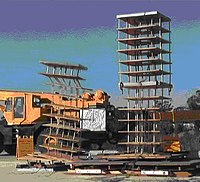
Photo from wikipedia
Abstract Offshore floating wind turbines are widely recognized as promising renewable energy devices capable of harnessing wind energy in deep water. In addition to mooring lines, hydrostatic stiffness of the… Click to show full abstract
Abstract Offshore floating wind turbines are widely recognized as promising renewable energy devices capable of harnessing wind energy in deep water. In addition to mooring lines, hydrostatic stiffness of the floating platform plays a key role in the stability of the offshore floating wind turbine. Apart from the geometry of platform, hydrostatic stiffness depends on its degrees of freedom. Therefore, it changes with motions of floating wind turbine and should be computed instantaneously. However, it is common practice to neglect the platform degrees of freedom and use linear hydrostatic stiffness in floating wind turbines analysis. Linear hydrostatic stiffness neglects the platform's motion and is computed at its undisplaced position. These shortcomings of linear hydrostatic stiffness can significantly influence the dynamic response of floating wind turbine. In the current study, a nonlinear hydrostatic stiffness with the purpose of its use in the analysis of offshore floating wind turbines is presented. The presented nonlinear hydrostatic stiffness uses the instantaneous position of floating platform and takes into account platform degrees of freedom. The effect of nonlinear hydrostatic stiffness is demonstrated through analysis of three leading types of floating wind turbines. The results show influence of hydrostatic nonlinearity on dynamic responses of floating wind turbines.
Journal Title: Applied Ocean Research
Year Published: 2021
Link to full text (if available)
Share on Social Media: Sign Up to like & get
recommendations!